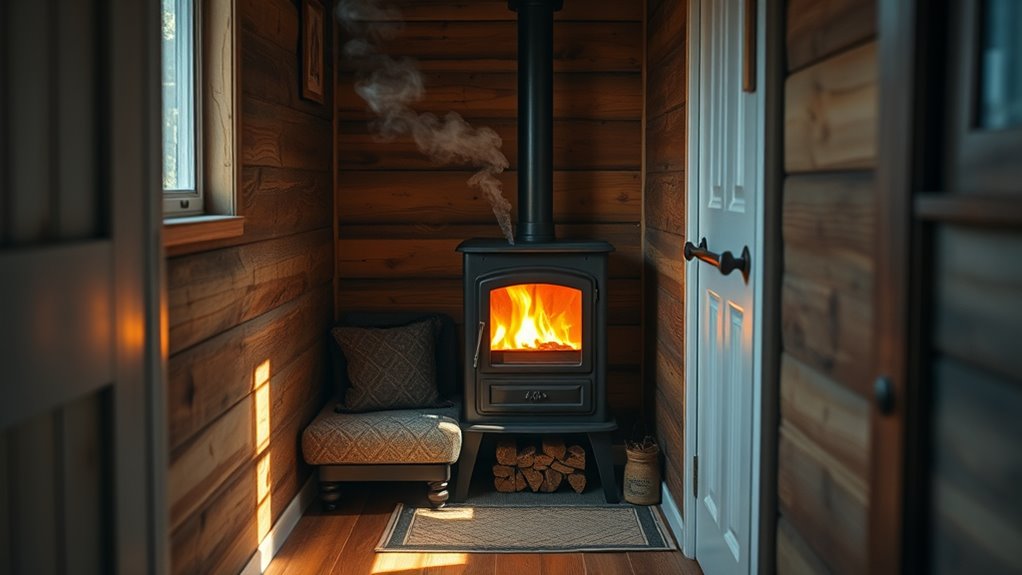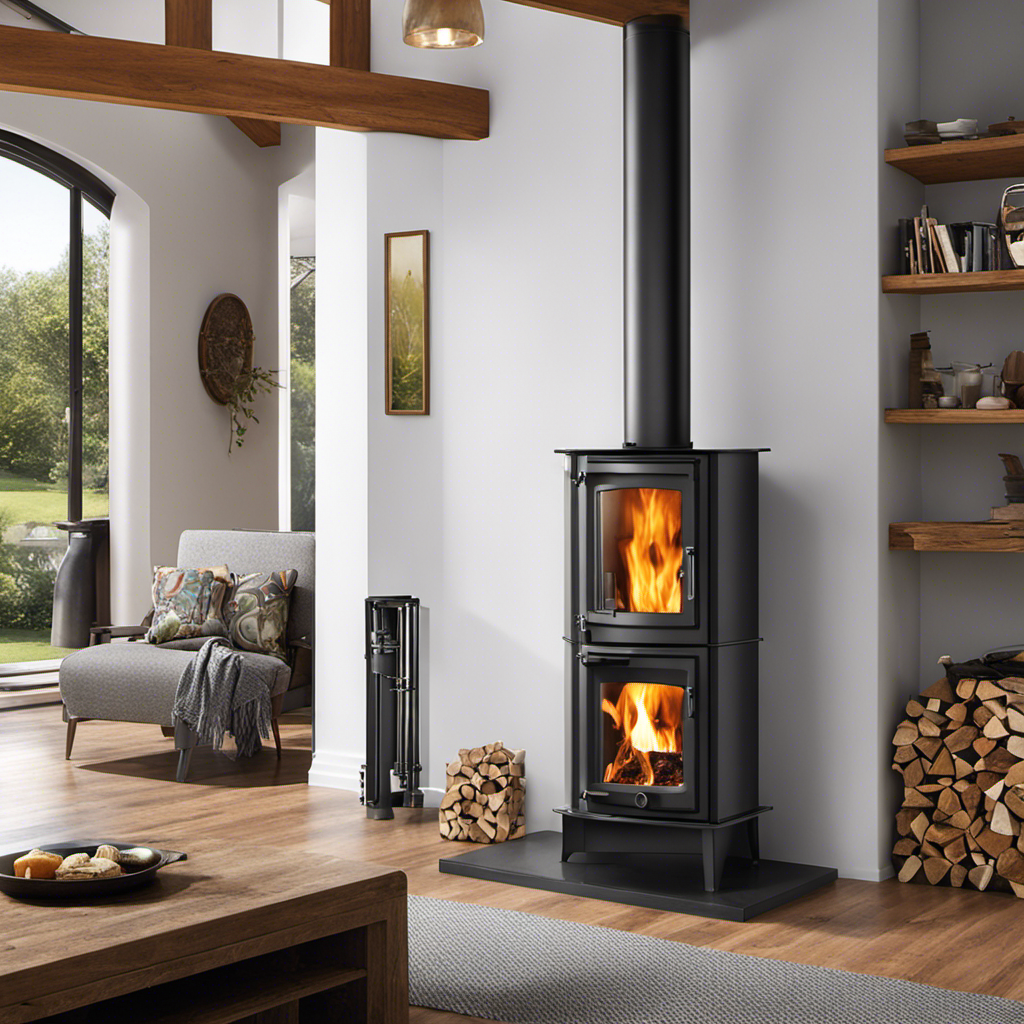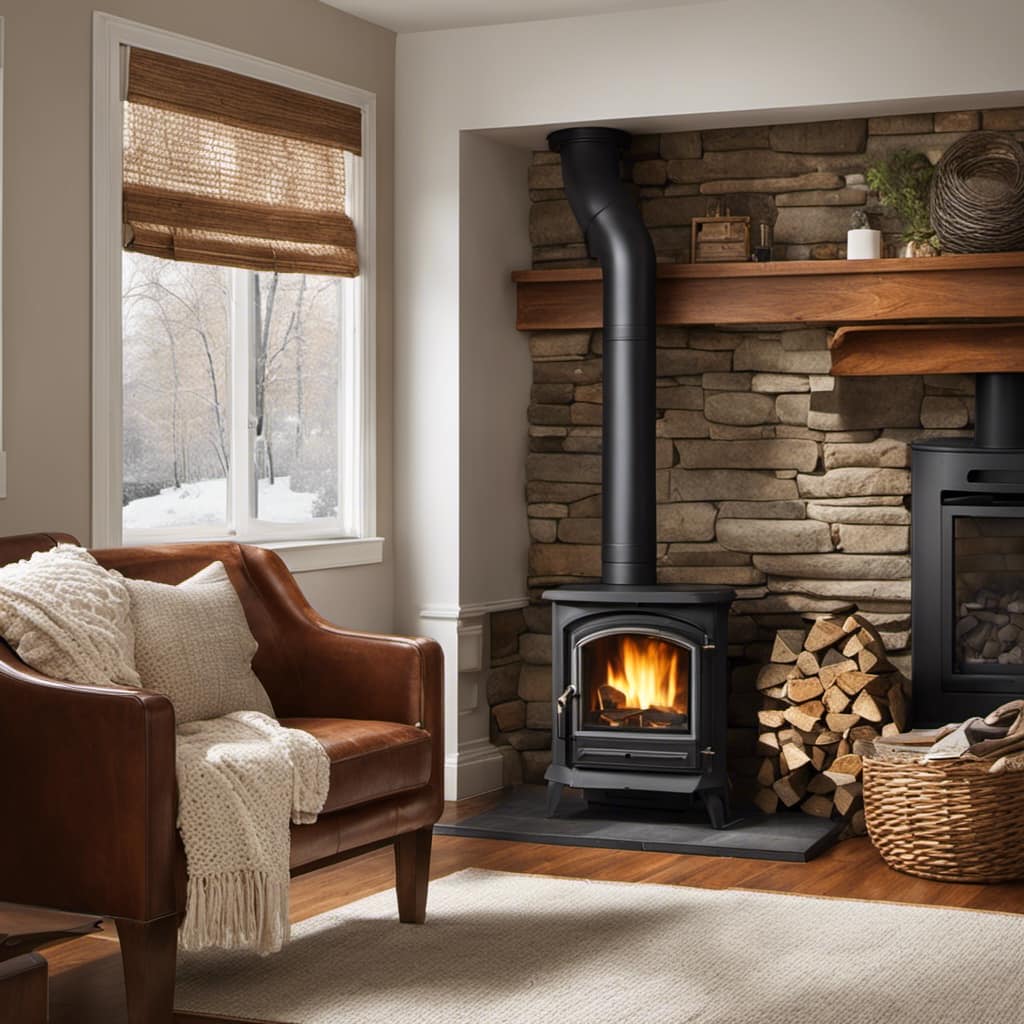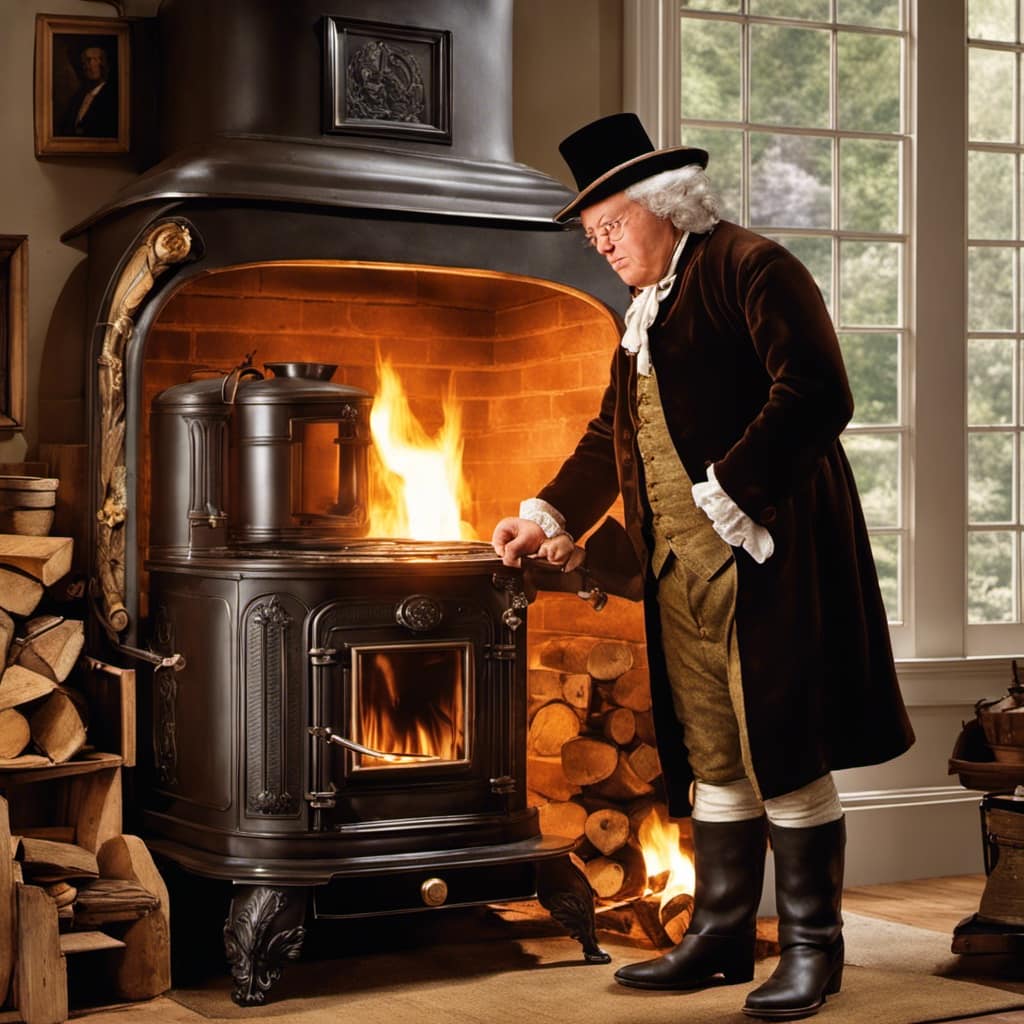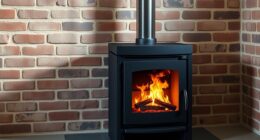To keep your tiny home warm with a wood stove, choose a compact, efficient model that fits your space and provides enough heat. Position it carefully, ensuring proper clearances from walls and combustibles, and use safe installation practices. Keep vents clear, install detectors, and clean the chimney regularly for safety. Good insulation and ventilation help distribute heat evenly. If you want expert tips on maximizing warmth safely, learn more below.
Key Takeaways
- Choose a compact, efficient wood stove suited for small spaces to maximize heat without sacrificing safety or style.
- Properly position the stove with adequate clearance, ventilation, and airflow management to ensure safety and even heat distribution.
- Regularly inspect and clean the chimney, stove, and vents to maintain safety, efficiency, and prevent creosote buildup.
- Insulate the tiny home effectively and seal drafts to retain warmth and improve energy efficiency.
- Use accessories like fans and heat shields, and maintain proper airflow to enhance comfort and maximize heat output.
Selecting the Ideal Wood Stove for Compact Spaces

When choosing a wood stove for a tiny home, it’s essential to prioritize compactness without sacrificing heating efficiency. You’ll find various wood stove styles, from traditional cast iron to modern designs, each offering unique aesthetic and functional benefits. Consider your space limitations and select a style that fits snugly without crowding your interior. Space-efficient designs are particularly popular for their ability to maximize heating in small areas. Equally important is the heating capacity; too small, and it’ll struggle to warm your entire space, too large, and it could be inefficient and cumbersome. Measure your area carefully and choose a stove rated appropriately for your square footage. A well-chosen wood stove balances style and function, providing reliable warmth while fitting seamlessly into your tiny home’s cozy environment. Additionally, always ensure your stove installation complies with safety standards, and maintain regular inspections to prevent fire hazards. Incorporating space optimization strategies can help you create a comfortable and efficient heating setup in your small home. Proper insulation plays a crucial role in heat retention, making your heating system more effective and energy-efficient.
Essential Safety Precautions When Using a Wood Stove

Using a wood stove safely is essential to prevent accidents and guarantee efficient heating in your tiny home. To ensure fire safety and proper stove maintenance, follow these precautions: 1. Keep combustible materials at least three feet away from the stove at all times. 2. Regularly inspect and clean your stove and chimney to prevent creosote buildup. 3. Use a sturdy, non-combustible hearth pad beneath the stove for added protection. 4. Install smoke and carbon monoxide detectors and test them monthly. 5. Proper ventilation is crucial to prevent dangerous buildup of gases inside your tiny home. Additionally, utilizing home furnishings like heat-resistant barriers can improve safety and efficiency. Proper installation and maintenance of your stove, following manufacturer guidelines, is also vital for safe operation and optimal heat output. Incorporating home safety measures such as security systems can further enhance your overall safety while living in a tiny home.
Proper Installation and Placement Tips for Small Areas
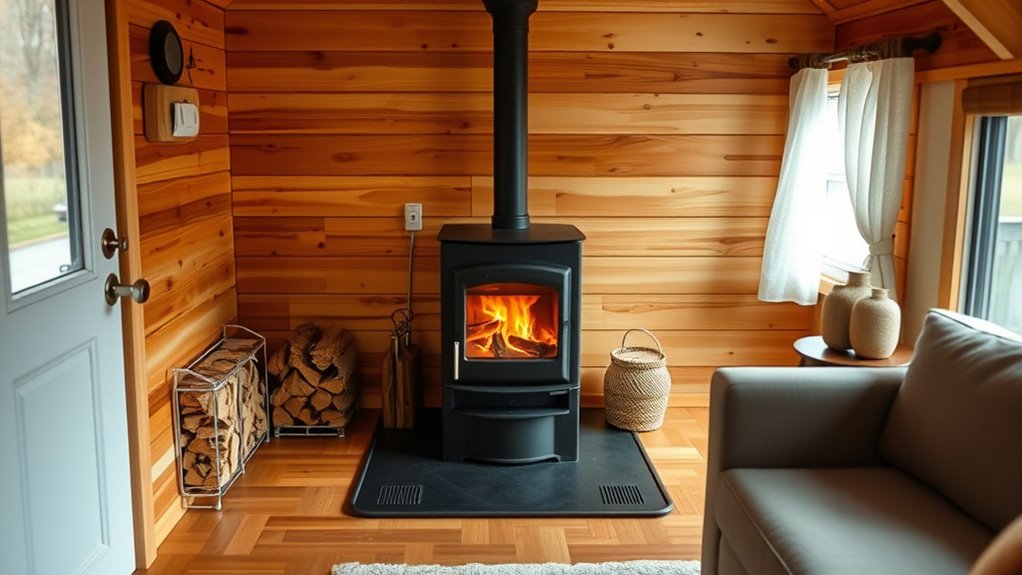
To get the most out of your small heating setup, you need to focus on proper stove placement. Make sure there’s enough clearance and spacing around the stove for safety and efficient heat distribution. Proper placement not only enhances safety but also maximizes the stove’s efficiency in warming your space. Also, guarantee good ventilation and airflow to keep the space comfortable and safe. Incorporating appropriate decor elements can enhance the cozy ambiance while ensuring safety standards are maintained. Additionally, understanding cost considerations can help you plan for potential expenses related to installation and safety features. Recognizing the importance of attention in practice can also improve your overall safety and effectiveness in managing your heating setup. Ensuring your stove is positioned on a non-combustible surface further reduces fire hazards and supports safe operation.
Optimal Stove Placement
Properly placing your stove is essential for safety and efficiency in small spaces. To optimize placement, consider these key tips:
- Position the stove where it can evenly distribute heat without blocking pathways.
- Choose a spot that allows for proper clearance, ensuring safe operation.
- Place the stove where it can complement decorative accents and enhance aesthetic integration.
- Avoid tight corners or cluttered areas that hinder airflow and access.
- Incorporate proper ventilation solutions to maintain indoor air quality and meet safety standards building codes and permits.
- Be mindful of conflict resolution in your space planning to prevent disputes over shared areas and ensure everyone feels comfortable and safe.
- Additionally, understanding privacy and cookie usage can help create a comfortable environment, even in shared living spaces.
Clearances and Spacing
Ensuring correct clearances and spacing is vital for safe and efficient stove operation in small spaces. You need to follow clearance regulations to prevent fire hazards and ensure proper heat distribution. Keep the stove at least the minimum distance from walls, furniture, and other combustible materials, as specified by the manufacturer. Use fire resistant materials, such as non-combustible hearth pads and heat shields, to protect surrounding surfaces. Proper spacing not only prevents overheating but also allows for safe maintenance and operation. Measure carefully before installation, and double-check local building codes to ensure compliance. Remember, maintaining recommended clearances is essential for safety, efficiency, and the longevity of your heating system in your tiny home. Understanding angel numbers can also offer spiritual guidance during your installation process. Additionally, being aware of AI in Education advancements can help you stay informed about innovative safety and technology solutions for home heating. Proper stove placement is crucial in maximizing heat output and minimizing potential hazards. Paying attention to clearance requirements ensures your setup adheres to safety standards and promotes optimal performance. Properly assessing local building codes before installation can prevent costly adjustments later and ensure your tiny home remains compliant and safe.
Ventilation and Airflow
Have you considered how critical ventilation and airflow are for your tiny home’s heating efficiency and safety? Proper airflow control guarantees your wood stove functions safely and maintains good indoor air quality. To optimize placement:
- Position the stove away from windows and vents to prevent drafts.
- Ensure adequate clearance around the stove for airflow and safety.
- Install venting that promotes even heat distribution.
- Use exhaust fans or air inlets to regulate airflow and prevent buildup of fumes.
- Incorporate automatic airflow controls to optimize combustion and safety in small spaces.
Good ventilation reduces risk of carbon monoxide buildup and improves indoor air quality. It also helps maintain consistent heat, preventing hotspots or cold spots. Small spaces rely heavily on proper ventilation techniques to stay safe and cozy. Paying attention to ventilation and airflow control maximizes your tiny home’s warmth and safety.
Effective Insulation and Ventilation Strategies

Choosing the right insulation materials can make a big difference in keeping your tiny home warm and energy-efficient. Proper ventilation techniques guarantee fresh air flows in without losing heat, maintaining comfort year-round. Effective insulation not only reduces heating costs but also prevents drafts and cold spots, ensuring consistent warmth. By focusing on these strategies, you’ll create a cozy, well-ventilated space that stays comfortable in any season. Incorporating low-carb and keto-friendly alternatives in your heating setup can also help reduce energy consumption and support a sustainable lifestyle.
Insulation Material Choices
Selecting the right insulation materials is essential for maintaining a comfortable and energy-efficient tiny home. Your choice of insulation material options impacts heat retention and overall comfort. For effective thermal barrier choices, consider:
- Spray foam insulation for seamless coverage and high R-values.
- Rigid foam boards, which are lightweight and easy to install.
- Mineral wool or rock wool, offering fire resistance and soundproofing.
- Fiberglass batts, a budget-friendly and widely available option.
Each option provides different benefits, so choose based on your climate, budget, and installation preferences. Proper insulation minimizes heat loss and reduces your reliance on the wood stove, making your tiny home warmer and more energy-efficient. Selecting the right thermal barrier choices ensures cozy warmth year-round.
Proper Ventilation Techniques
Did you know that proper ventilation is just as crucial as insulation for maintaining a comfortable tiny home? Good ventilation helps improve air quality by reducing moisture, odors, and indoor pollutants. To achieve this, guarantee your tiny home has effective outdoor venting, such as exhaust fans or vents that allow stale air to escape. Proper outdoor venting prevents condensation and mold growth, which can compromise your home’s structure and air quality. Regularly check that vents are unobstructed and correctly positioned to promote airflow. Also, consider installing a mechanical ventilation system to regulate air exchange even when windows are closed. This way, you keep fresh air circulating, reduce indoor pollutants, and create a healthier, more comfortable living environment in your tiny home.
Maintaining and Cleaning Your Wood Stove for Longevity
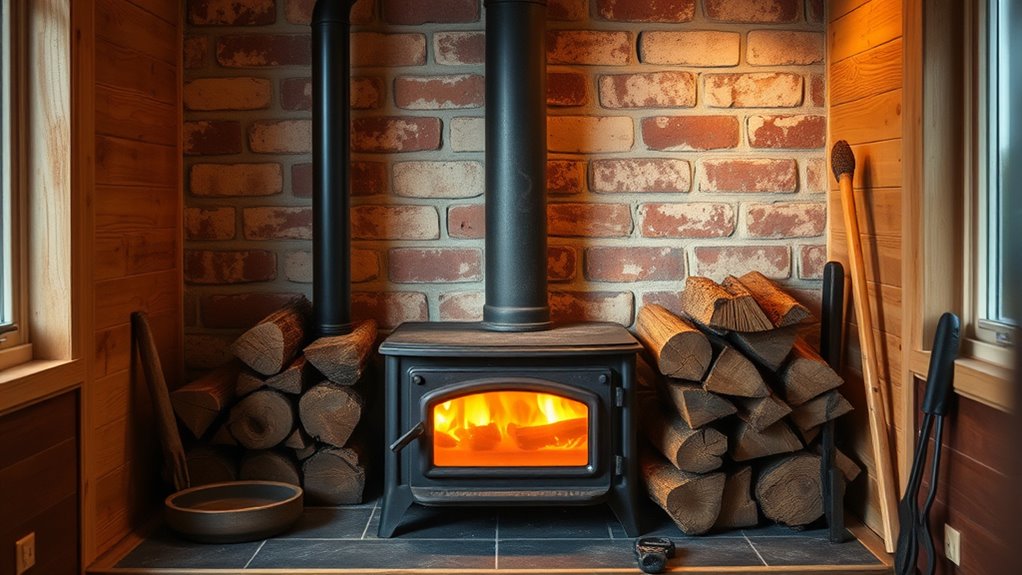
Regular maintenance and cleaning are essential to guarantee your wood stove operates efficiently and lasts for years. To keep it in top shape, follow these steps:
Routine cleaning and maintenance ensure your wood stove’s efficiency and longevity.
- Regularly inspect and perform chimney maintenance to prevent creosote buildup.
- Dispose of ash safely by removing excess ash after each burn session.
- Clean the firebox and glass door to prevent soot accumulation.
- Check and clean the air vents to ensure proper airflow.
Enhancing Efficiency and Comfort in Tiny Homes

To maximize comfort and efficiency in your tiny home, focus on smart heating strategies and insulation improvements that make the most of your wood stove. Proper firewood storage keeps your fuel dry and easily accessible, reducing waste and ensuring consistent warmth. Use stove accessories like fans or heat shields to distribute heat evenly and prevent heat loss. Sealing gaps around windows and doors minimizes drafts, helping your stove work more efficiently. Consider installing thermal curtains or insulation panels to retain heat longer. Regularly maintaining your stove and keeping accessories in good condition boosts performance and safety. These steps guarantee your tiny home stays warm, comfortable, and energy-efficient, making the most of your wood stove’s potential while reducing fuel consumption.
Frequently Asked Questions
How Do I Choose a Wood Stove That Fits My Tiny Home’S Aesthetic?
When choosing a wood stove to match your tiny home’s aesthetic, consider design coordination to guarantee it complements your space. Look for models with sleek lines or vintage charm, depending on your style. Material selection is also key; choose finishes like matte black, stainless steel, or cast iron to blend seamlessly. Prioritize size to fit your space comfortably while maintaining visual harmony, so your stove becomes both functional and a design element.
Can I Install a Wood Stove Myself in a Small Space?
Imagine you’re handy and want to save money by doing a DIY installation. You can install a wood stove yourself, but safety considerations are vital. A homeowner in a compact apartment successfully did it by following manufacturer instructions and local codes. Make certain proper clearance, ventilation, and flue setup, and consider consulting a professional to verify your work. Prioritize safety to enjoy cozy warmth without risks.
What Are the Environmental Impacts of Using a Wood Stove?
Using a wood stove impacts the environment by contributing to air pollution through emissions of fine particles and volatile organic compounds. It can also lead to deforestation if wood is sourced unsustainably. While it’s a renewable energy source, you should consider these effects and choose sustainably harvested wood to minimize your environmental footprint. Proper maintenance and efficient stoves can help reduce air pollution and make your heating more eco-friendly.
How Often Should I Schedule Professional Maintenance for My Stove?
Ever wonder how to keep your stove running safely and efficiently? You should schedule professional maintenance at least once a year. This includes a thorough chimney inspection and ash removal to prevent buildup and potential fire hazards. Regular check-ups guarantee your stove operates smoothly, saves energy, and prolongs its lifespan. Don’t wait until problems arise—annual maintenance is your best bet for warm, worry-free heating all season long.
Are There Alternative Fuels Compatible With Small Wood Stoves?
You might wonder if there are alternative fuels compatible with your small wood stove to improve fuel efficiency. While wood is the primary fuel, some stoves can use pelletized biomass or manufactured logs. These options often burn cleaner and more effectively, helping you save on fuel costs. Always check your stove’s manufacturer guidelines before trying alternative fuels to guarantee safety and peak performance.
Conclusion
With the right wood stove, your tiny home becomes a cozy, crackling haven—a warm heartbeat in a sea of small spaces. By choosing wisely, practicing safety, and keeping everything well-maintained, you’ll turn your compact retreat into a radiant sanctuary. Think of your stove as the sun itself, spreading comfort and light, proving that even the smallest spaces can glow with warmth and charm. Embrace these tips, and watch your tiny home shine bright with inviting heat.

